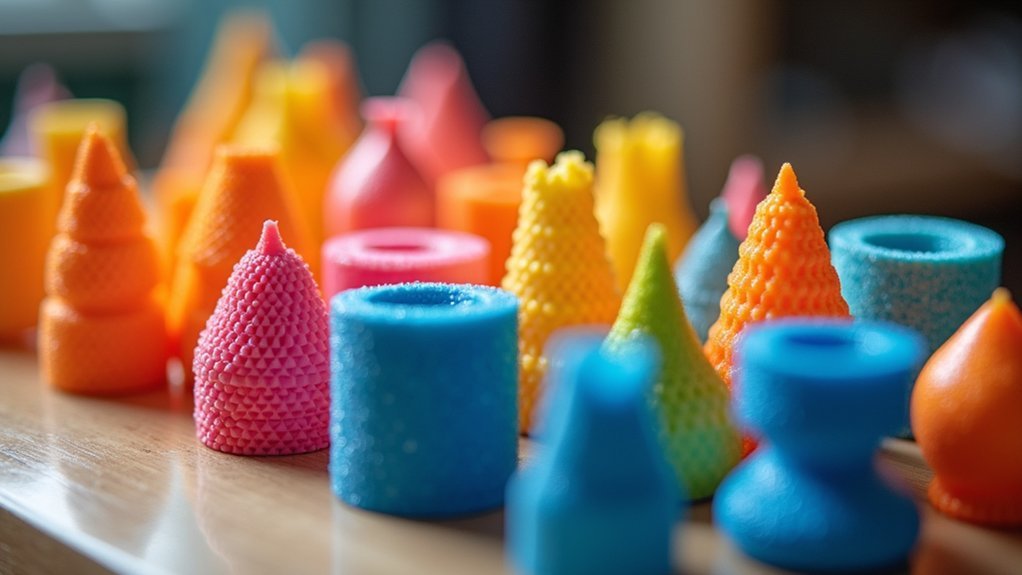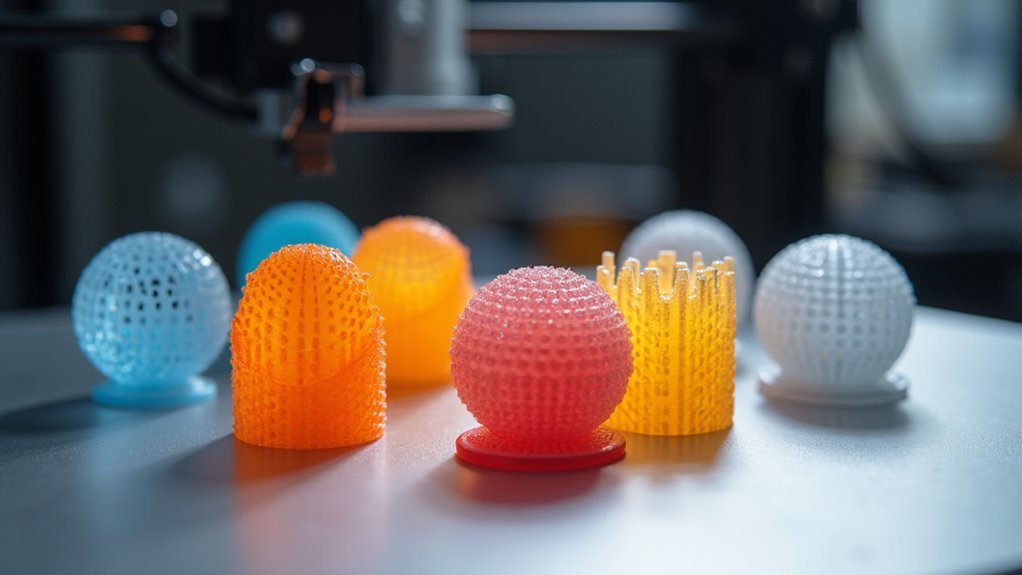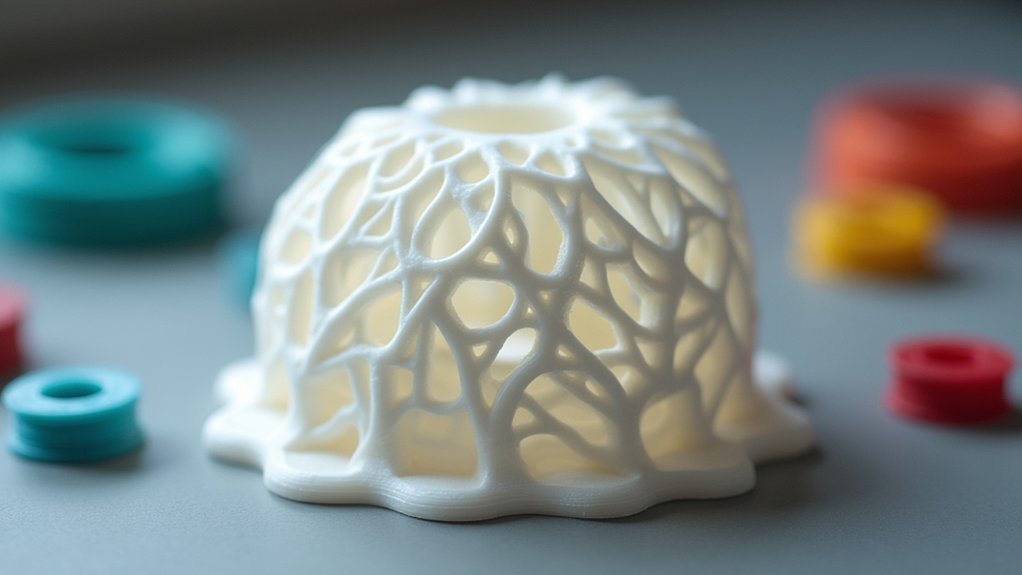For ideal PLA printing results, you’ll want to use 10-20% infill density for decorative items and prototypes, 30-50% for functional parts, and up to 70-100% for high-stress mechanical components. Pair these densities with strength-optimized patterns like cubic for multidirectional support, triangular for even load distribution, or gyroid for superior strength-to-weight ratios. Grid patterns work well when you need faster print speeds with reasonable strength. The thorough strategies below will help you master these techniques for any project.
Understanding PLA Infill Requirements and Properties

Why does choosing the right infill density matter so much for your PLA prints? Your infill density directly impacts both material usage and structural integrity.
Infill density is the critical balance between material efficiency and print strength that determines your project’s success.
PLA’s excellent properties, including low shrinkage and superior layer adhesion, make it compatible with various infill densities ranging from 10% to 50%.
You’ll find that decorative items perform well with 10-20% infill density, minimizing material waste while maintaining visual appeal.
However, functional parts requiring mechanical strength need 30-50% density for ideal durability.
PLA’s forgiving nature allows you to experiment with different infill patterns like Grid, Honeycomb, and Cubic without compromising print quality.
Understanding these requirements helps you balance print speed, material consumption, and strength.
Your choice between infill patterns and densities ultimately determines whether your PLA prints meet their intended purpose effectively.
Optimal Infill Density Ranges for Different PLA Applications
You’ll find that different PLA applications demand vastly different infill densities to achieve ideal results.
For decorative items and miniature models, you can use low densities of 0-20% to save material and reduce print time while maintaining adequate structure.
However, when you’re printing functional mechanical parts, you’ll need high densities of 50-100% to guarantee the strength and durability required for stress-bearing applications.
Low Density Applications
When you’re creating decorative items, prototypes, or models that prioritize aesthetics over strength, low-density infill settings of 10-20% will serve your needs perfectly.
This low infill range considerably reduces material usage while maintaining adequate structural integrity for toys, models, and everyday objects. You’ll notice noticeably shorter printing time compared to higher density settings, making these projects more efficient and cost-effective.
Choose infill patterns like Lines and Zig Zag for ideal speed and minimal material requirements. At 15-20% density, your prints remain lightweight yet structurally sound for non-functional applications.
For art pieces, low infill creates fascinating internal structures that enhance visual appeal when revealed. These settings excel for decorative purposes where strength isn’t critical but aesthetics and efficiency matter most.
High Density Requirements
Functional parts demand considerably higher infill densities between 50-100% to handle real-world stresses and mechanical loads.
When you’re creating components that’ll face mechanical stress or heavy use, you can’t compromise on structural integrity. These high density requirements guarantee your printed parts won’t fail under pressure.
For specialized applications like gears, brackets, or tools, you’ll want to push your infill density toward the upper range of 70-100%.
This creates a nearly solid interior that maximizes strength and durability. The strongest infill pattern choices like gyroid or cubic provide excellent structural support while maintaining reasonable print times.
Best Infill Patterns for PLA Strength and Performance

While PLA’s forgiving nature makes it accessible to beginners, selecting the right infill pattern dramatically impacts your print’s strength and performance characteristics.
The best infill pattern for your PLA prints depends on your specific requirements and intended use.
Choosing the optimal infill pattern requires careful consideration of your project’s specific strength, weight, and functionality demands.
Triangular infill excels at distributing loads evenly, making it ideal for functional parts requiring maximum strength.
Honeycomb delivers exceptional strength-to-weight ratios, perfect when you need durability without excess material.
Cubic infill provides multidirectional strength while keeping material consumption reasonable, especially valuable for mechanical components.
For specialized applications, consider Gyroid’s isotropic strength properties or Octet’s robust framework for thin-walled designs.
Pair these patterns with ideal infill percentage recommendations of 20-40% density to achieve the perfect balance between structural integrity and material efficiency in your PLA projects.
Grid Vs Cubic Vs Gyroid: Pattern Comparison for PLA
When you’re choosing between Grid, Cubic, and Gyroid patterns for your PLA prints, you’ll need to weigh their distinct strength characteristics against print time requirements.
Grid offers balanced X-Y strength with fast printing.
Cubic excels in vertical load-bearing with moderate speed, while Gyroid provides superior all-directional strength but takes longer to print.
Your project’s specific stress requirements and time constraints will determine which pattern delivers the best performance for your needs.
Strength Performance Analysis
Understanding how different infill patterns affect your PLA print’s structural integrity becomes essential when you’re designing parts that’ll face real-world stresses.
Each pattern delivers distinct strength characteristics that match specific applications.
Grid patterns excel in vertical strength scenarios, making them perfect when you need upward load resistance.
Cubic patterns provide superior bending force resistance through their 45-degree interwoven structure, delivering consistent omnidirectional strength.
Meanwhile, Gyroid patterns offer exceptional strength-to-weight ratios with their complex lattice design, distributing forces evenly across dynamic loads.
- Grid Pattern: Ideal for vertical loads and moderate strength requirements at 20-30% infill density
- Cubic Pattern: Superior bending resistance with consistent directional strength performance
- Gyroid Pattern: Best strength-to-weight ratio for lightweight, flexible applications requiring dynamic load distribution
Print Speed Comparison
Since print speed directly impacts your project timeline and production efficiency, choosing between Grid, Cubic, and Gyroid patterns requires balancing speed against your specific performance needs.
The Grid infill pattern delivers the fastest print speed, achieving approximately 20% time reduction compared to complex alternatives. You’ll find Grid outperforms both Cubic and Gyroid, printing 10-15% faster than Cubic infill and up to 25% quicker than Gyroid at identical density settings.
Cubic infill strikes a middle ground, offering reasonable print speed while providing enhanced three-dimensional structural support for functional parts.
Gyroid, despite its superior strength-to-weight ratio and uniform directional properties, requires longer print durations due to its intricate lattice geometry.
When deadlines matter, Grid maximizes efficiency for basic applications requiring moderate strength.
Lightweight PLA Prints: Low-Density Infill Strategies

The challenge of creating lightweight PLA prints lies in finding the sweet spot between material efficiency and structural integrity.
When you’re targeting low-density applications, an infill density of 10-20% delivers ideal results for lightweight PLA prints. This range greatly reduces material usage while maintaining adequate strength for decorative or non-functional items.
You’ll find several infill patterns available that excel at low densities:
- Lines or Zig Zag patterns – Fastest printing with minimal filament consumption
- Grid pattern – Balanced strength-to-weight ratio for moderate durability needs
- Honeycomb pattern – Enhanced visual appeal without major weight increase
Lower infill densities also boost your print speeds, making them perfect for rapid prototyping.
You’ll produce parts more efficiently while keeping material costs down, especially valuable when iterating through multiple design versions.
High-Strength PLA Parts: Dense Infill Configurations
When your PLA prints must withstand significant stress and loading, dense infill configurations become essential for achieving the structural integrity you need. For high-strength PLA parts, you’ll want to set your infill density between 50-100% to maximize durability and resistance to deformation.
Choose robust infill patterns like Cubic, Triangular, or Gyroid to optimize your strength-to-weight ratio. These patterns provide superior load-bearing capabilities compared to standard configurations.
While higher densities increase material usage, they’re vital for mechanical applications where failure isn’t an option.
Consider experimenting with advanced patterns like Octet for high-performance applications. This pattern creates strong, lightweight structures while reducing filament consumption.
Remember that increased infill density directly correlates with improved rigidity and stress resistance in your critical components.
Print Speed and Material Efficiency With PLA Infill
While maximum strength applications demand dense infill configurations, most PLA printing projects benefit from enhancing the balance between print speed and material consumption.
Most 3D printing projects achieve optimal results by prioritizing the balance between speed and material efficiency over maximum strength.
You’ll find that low-density infill between 10-20% delivers the fastest results while conserving filament, making it perfect for decorative items where structural integrity isn’t critical.
Medium-density infill at 25-40% provides an ideal sweet spot for everyday objects, offering reasonable strength without excessive print times or material waste.
For maximum material efficiency and speed, consider these pattern choices:
- Lines and Zig Zag patterns – Fastest printing options that minimize nozzle travel time
- Cubic patterns – Better strength-to-weight ratio at moderate infill density levels
- Gyroid patterns – Superior structural performance while maintaining reasonable print speeds
PLA-Specific Infill Settings and Printer Considerations
PLA’s unique thermal and mechanical properties require specific infill adjustments that differ from other 3D printing materials.
You’ll achieve ideal results by setting your infill density between 20-30% for most applications, providing excellent strength-to-weight ratios while conserving material. The grid pattern works exceptionally well for PLA prints due to its efficient structure and faster printing speeds compared to complex geometries.
For functional components, increase your infill density to 40-60% to guarantee adequate durability.
Your layer height selection directly impacts infill effectiveness—smaller layer heights enhance interlayer bonding and overall quality.
Consider your printer’s capabilities when choosing patterns, as some advanced geometries require sophisticated extrusion systems. Honeycomb patterns offer superior strength but demand more precise temperature control than simpler grid configurations for consistent PLA prints.
Frequently Asked Questions
What Is the Best Infill Pattern for PLA Strength?
You’ll want Cubic infill for maximum PLA strength since it provides excellent durability in all directions. If you’re prioritizing weight reduction while maintaining strength, Honeycomb infill offers the best strength-to-weight ratio available.
What Is the Strongest 100% Infill Pattern?
You’ll find Cubic infill delivers the strongest results at 100% density, providing robust support in all directions through interlocking 45-degree patterns that resist forces from multiple angles effectively.
Is 20% Infill Strong Enough?
You’ll find 20% infill works well for decorative items and prototypes, but it won’t handle heavy loads or functional parts. You’ll need higher densities for structural strength and durability.
Is 40% Infill Too Much?
You’ll find 40% infill isn’t too much for functional parts needing durability, but it’s excessive for decorative items. You’re increasing print time and material costs without gaining necessary strength for simpler projects.





Leave a Reply